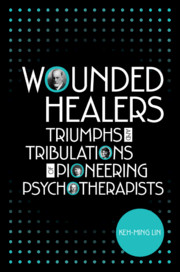Book contents
- Wounded Healers
- Advance Praise for Wounded Healers
- Wounded Healers
- Copyright page
- Contents
- Acknowledgments
- Introduction
- Part I Fin-de-Siècle Vienna
- 1 Sometimes a Cigar Is Just a Cigar
- 2 A Most Dangerous Method
- 3 We Are Abel: We Are Cain
- 4 Fear of Death and Trauma of Birth
- 5 From Character Analysis to Cloud Busting
- 6 Ernest Jones
- 7 Estranged Brilliance
- 8 When Freud Met Tiffany
- 9 Phoenix Forever
- Part II From Sea to Shining Sea
- References
- Index
4 - Fear of Death and Trauma of Birth
Otto Rank’s Tragic Saga
from Part I - Fin-de-Siècle Vienna
Published online by Cambridge University Press: 17 December 2020
- Wounded Healers
- Advance Praise for Wounded Healers
- Wounded Healers
- Copyright page
- Contents
- Acknowledgments
- Introduction
- Part I Fin-de-Siècle Vienna
- 1 Sometimes a Cigar Is Just a Cigar
- 2 A Most Dangerous Method
- 3 We Are Abel: We Are Cain
- 4 Fear of Death and Trauma of Birth
- 5 From Character Analysis to Cloud Busting
- 6 Ernest Jones
- 7 Estranged Brilliance
- 8 When Freud Met Tiffany
- 9 Phoenix Forever
- Part II From Sea to Shining Sea
- References
- Index
Summary
Known for the concept of the “trauma of birth,” Otto Rank’s contributions to the fields of psychoanalysis and psychotherapy have largely been obscured. Rank came from an impoverished family with an alcoholic father, and was sent to a trade school to become a locksmith. However, his unique insight into applying psychoanalytic concepts in understanding philosophy and art caught the attention of Freud, who supported him in his college education and graduate studies. Freud hired him to be the secretary of the Vienna Psychoanalytic Society, where he functioned as Freud’s “right hand man” for close to twenty years. Intriguingly, his “breaking away” from Freud’s circle coincided with Freud’s diagnosis of oral cancer and near-death from surgical complications. Ostracized by orthodox Freudians, he nevertheless was able to further explore pre-Oedipal issues and the significance of separation anxiety. He developed his patient-centered, brief psychotherapeutic approach, with particular focus on the “here and now” and on patients’ autonomy and self-healing potential. His ideas heralded the later developments of client-centered therapy, existential-humanistic therapy, and Gestalt therapy.
Keywords
- Type
- Chapter
- Information
- Wounded HealersTribulations and Triumphs of Pioneering Psychotherapists, pp. 55 - 63Publisher: Cambridge University PressPrint publication year: 2020



